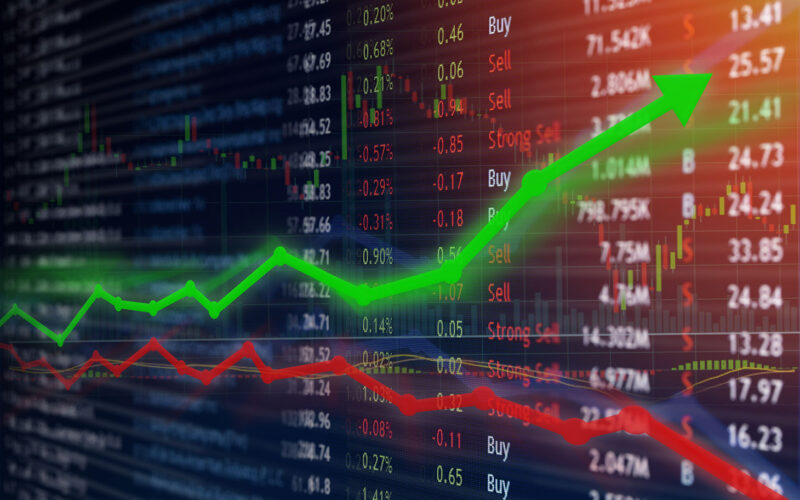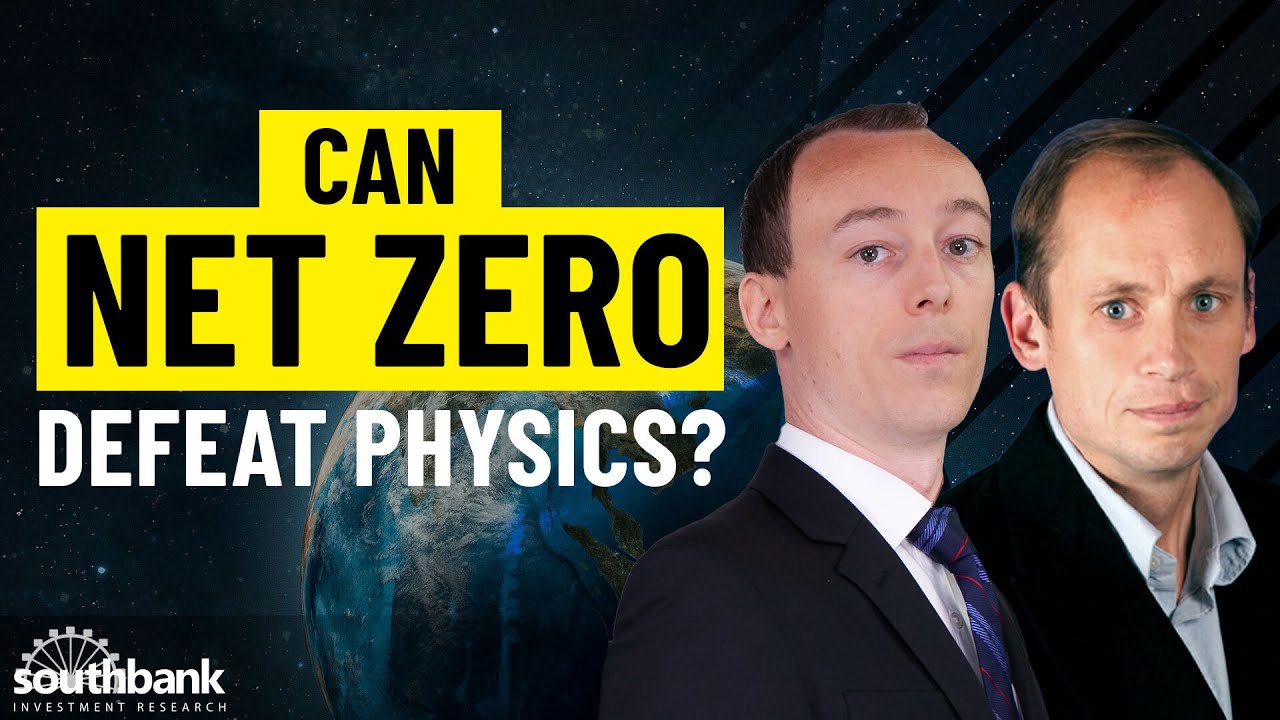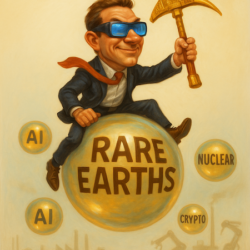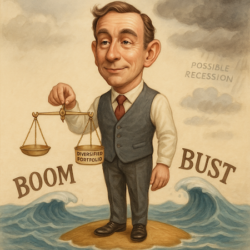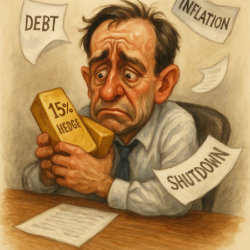I’m Jim Rickards.
Southbank Investment Research invited me to share the same strategies I’ve been giving my U.S. readers—on how to navigate and thrive in today’s chaotic markets.
And that’s something I don’t take lightly—because I’ve lived through chaos myself.
I’ve suffered two major financial setbacks in my life…
And I’m determined to pass on the lessons I learned from them — giving you the tools you need to achieve lasting peace of mind.
Because what happens to your money doesn’t just affect you, as I learned first-hand when I was 12 years old.
My father’s business collapsed. Then he was forced to declare bankruptcy. The bank foreclosed on our home and car. We had to move far away into my grandmother’s small cottage.
I slept on a porch that was badly insulated and quite cold in the winter. We had no money, no new clothes and went without food on some nights.
Luckily, I was smart enough to realize that education was my way out of poverty.
So I studied hard and got good grades, eventually attending Johns Hopkins University. Then I entered a joint program with the School of Advanced International Studies in Washington — earning an M.A. in International Economics.
Next came a degree from the University of Pennsylvania Law School in Philadelphia, followed by my first job as an international tax counsel for a major bank.
That job sent me around the world, gaining insights into foreign banking policies and practices…
As my experience and knowledge grew, I looked for new opportunities — becoming a regular fixture in Washington, DC.
In 1994, I decided to take my Wall Street and Washington experience to the hedge fund world… joining a company called Long-Term Capital Management (LTCM).
LTCM was huge, with ties to just about every bank and financial institution in the world.
Then its trading strategies went catastrophically wrong. It collapsed… threatening to take the global economy down with it.
Now, I was just a lawyer for LTCM, so I had nothing to do with the company’s trades. But like many, I had trusted the managers with my money…
Still, I worked tirelessly to negotiate LTCM’s bankruptcy. When it was all over, we had prevented a worldwide financial meltdown.
But I was out of a job — and 92% of my wealth had disappeared.
My search to understand what LTCM’s fund managers had done wrong led me to “complexity theory”… a branch of physics that uses limited information to predict complicated events.
So, I partnered with top names in the field to see if complexity theory could be used to predict capital markets, too.
My work eventually caught the attention of the U.S. Central Intelligence Agency (CIA).
After the Sept. 11 attacks, the CIA wanted to know if unusual stock market activity could predict terrorists’ next moves.
My experience in international finance and work with complexity theory made me a natural choice for the project.
That’s how I ended up as part of the team that pioneered a discipline called MARKINT, or market intelligence. It was a brand-new way of figuring out what was happening behind closed doors around the world.
But even today, I remain one of the few financial analysts applying complexity theory and MARKINT to forecast market behavior.
That’s why no one else is warning you about the financial avalanche I see ahead.
You won’t hear this from Wall Street. But you will hear it from me.
Because my job isn’t just to analyze the system—it’s to help you navigate it. To make sure you and your loved ones are never blindsided by forces you don’t understand.
And as long as I have a voice, you’ll have a guide.
So, keep an eye on your inbox. Tomorrow, I’m sending you one of the most crucial parts of our investment plans – and you don’t want to miss it.
Best,

Jim Rickards
Contributing Editor, Investor’s Daily
|
Can Net Zero Defeat Physics?
Now that Kemi Badenoch has admitted Net Zero is “impossible,” what has actually changed? Well, the law requiring us to reach Net Zero is still on the books. So, what happens when a law mandates the impossible? |
Mind the Gap
Bill Bonner, writing from Youghal, Ireland
On Monday, White House advisor Kevin Hassett stoked rumors that the president will ‘pause’ the tariffs to give nations a chance to come to terms with the Trump Team. Stocks shot up…appearing, for a while, to reverse the downward trend.
And again, yesterday morning, it looked like ‘the bottom was in.’
But then, The Donald put to rest any lingering hope that he is a reasonable man. CNN:
President Donald Trump is set to impose an astounding 104% in levies across all Chinese imports on Wednesday, White House Press Secretary Karoline Leavitt announced on Tuesday…China was already set to see tariffs increase by 34% on Wednesday as part of Trump’s “reciprocal” tariffs package.
But the president tacked on another 50% after Beijing didn’t back off its promise to impose 34% retaliatory tariffs on US goods by noon Tuesday, adding an additional 84% in duties.US stocks, which soared Tuesday morning, began moving lower off Leavitt’s comments. By 3 p.m. ET the Dow, Nasdaq and S&P 500 were all in negative territory.
Leavitt:
“President Trump has a spine of steel, and he will not break.”
The ‘spine of steel’ got hammered into its present shape by toady ‘advisors’ — prominently, Pete Navarro.
According to press reports, others insiders preferred to use tariffs as a bargaining tool. But Navarro is not really interested in a way to encourage free trade. Navarro:
“To those world leaders who, after decades of cheating, are suddenly offering to lower tariffs — know this: that’s just the beginning,” he wrote.
‘The beginning of what,’ we might wonder? Nothing good, is our guess.
Elon Musk says Navarro is ‘truly a moron… dumber than a sack of bricks.’ Musk:
“What he says is demonstrably false.”
Elon is probably right about that. Still, it is a helluva thing for White House insiders to say in public. Besides, Navarro’s tariffs are the centerpiece of Trump’s economic policy. If the architect is a moron, what does that make the builder? Why is Musk on the team?
Musk is the biggest backer…and now a prominent part…of the Trump Team. With his support, Trump and Navarro have up-ended the more-or-less free trade system that has lifted more people out of poverty than any economic policy in history.
In China alone, some 800 million people have been brought into the modern economy in a single generation, with standards of living now almost comparable to those in Europe or the US.
Navarro misunderstands this phenomenon in simpleton terms:
‘The US cumulative trade deficits in goods from 1976 — the year the chronic deficits began — to 2024 have transferred over $20 trillion of American wealth into foreign hands. That’s more than 60% of US GDP in 2024. Foreign interests have taken over vast swaths of US farmland, housing, tech companies, and even part of our food supply.’
The US transferred real wealth? Not exactly. The foreigners gave us cars, T-shirts, gizmos and gadgets. That was real wealth. What did we give them in return? Debt securities — dollars (bearer notes)…and Treasuries.
That’s what a deficit means. If we had given them real output, of real value equal to what they gave us, there wouldn’t be a trade deficit. Instead, we gave them output of less value than what they gave us…leaving us with a deficit and them with a surplus. This gap was filled with dollars.
They gave us things of real value. We gave them I.O.Us…
As we discussed yesterday, Trump’s advisors take the volume of the trade deficit as a measure of “cheating.” If a country is giving us more than we give it, it is ‘ripping us off,’ they say. This claptrap is typical of the ‘blame someone else’ approach that works so well in politics, but never in economics.
But by this formula, the US was a cheater for the 100 years — roughly from the 1870s to the 1970s. It ripped off the rest of the world by sending it tractors, tanks, oil, food, clothes, movies — you name it.
In return, it received its trade surplus in the form of gold. That’s why the US has more gold than any other nation.
But then, something changed. What? How can you explain a complete turnabout… wherein Americans went from being the world’s largest exporters to its biggest chumps?
The fault, dear reader, was not in our stars, nor in our neighbors, but in ourselves. What really happened was that the US changed the international money system.
After 1971, America was still the world’s largest exporter…but it was exporting its new, gold-free paper dollars (and other debt instruments), not real goods. The US produces dollars (bearer notes) as well as long-term Treasury bonds. These are much easier to manufacture than automobiles or underwear.
Elon Musk produces real goods. A machine that drills huge holes. A car that is now a worldwide leader. A spacecraft program capable of rescuing NASA astronauts. A satellite system that allows communications all over the world.
He’s built a worldwide empire of real companies producing real things (though perhaps grossly over-valued in the US by investors). He understands how a real economy works. What he doesn’t understand is politics.
And Navarro? What does he know? Does he know anything at all?
Musk:
“He ain’t built s#!%.”
More to come…
Regards,

Bill Bonner
Contributing Editor, Investor’s Daily
For more from Bill Bonner, visit www.bonnerprivateresearch.com
